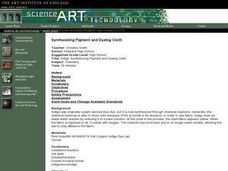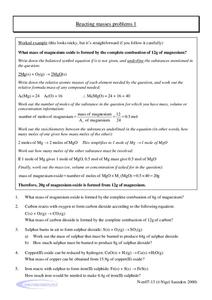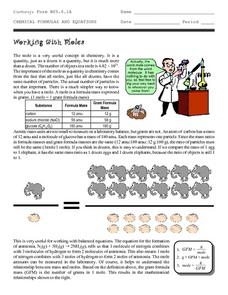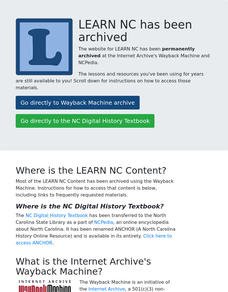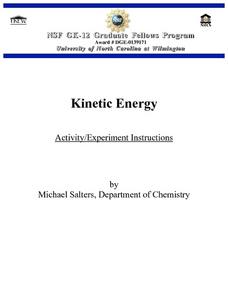Curated OER
Pre-Lab Questions-Acids and Bases
For this acids and bases worksheet, students answer eight questions about acids and bases prior to doing a titration lab. They define both acids and bases and explain what a neutralization reaction is as well as a titration.
Curated OER
Synthesizing Pigment and Dyeing Cloth
Students create a synthetic dye and oxidize the dye and record the effects.
Texas State Energy Conservation Office
Investigation: Chemical Models
Science teams make models of four different hydrocarbon compounds that we commonly use for fuel. Then they demonstrate chemical reactions that result when energy is produced. This can be used as an enrichment when your class is studying...
Curated OER
Electrolysis Reactions
In this electrolysis reactions worksheet, students determine the mass of a compound and the time required for specific electrolysis reactions. This worksheet has 5 problems to solve.
Cornell University
The Galvanic Cell Game
Play a little game with your classes! Young scholars expand on their understanding of oxidation/reduction reactions in a game-based activity. They build a Galvanic cell with game pieces while learning about each component and their...
Curated OER
The Preparation of Teraamminecopper(II) Sulphate-1-water
In this complex salt learning exercise, students create teraamminecopper(II)sulphate-1-water using copper(II)sulphate, concentrated ammonia and ethanol. Students determine the formula mass for their product, the theoretical yield of the...
Curated OER
Percent Yield
In this percent yield worksheet, students solve 4 problems. They find the percent yield given the chemical reaction, the mass of the reactants and the mass of the products. Given the percent yield students find the liters of a substance...
Curated OER
Reacting Masses Problems
In this chemical reactions instructional activity, students follow steps to determine the mass of compounds formed by the combustion of an element. This instructional activity has 5 problems to solve.
Curated OER
Redox Titration Problems Involving Manganate
In this titration worksheet, students determine the number of moles of an ion present in given solutions. Students calculate the relative formula mass and the concentrations of ions for solutions. This worksheet has 7 problems to solve.
Curated OER
Activity #6 How Fast Do Reactions Go?
Students name the factors (concentration, temperature, and a catalyst) which can affect the rate of a chemical reaction. They use their knowledge of particle theory to explain their observations. Pupils comprehend that the...
Curated OER
Experimental Rate Law
In this reaction rate worksheet, students determine the molecularity of a reaction plus show that the predicted rate law equals the experimental rate law. This worksheet has 3 problems to solve.
Curated OER
Working with Moles
In this moles activity, high schoolers read about mass, formula mass and moles. They calculate the masses of given numbers of moles of compounds and they calculate the number of moles of given masses of compounds.
Curated OER
Avoiding Carbon Dioxide Emissions from Burning Fossil Fuels
Students calculate stoichiometrically the amount of carbon dioxide that would be emitted from burning a mole of varios alkanes that comprise fossile fuels. If the energy released from burning a mole of these alkanes is known, then the...
Curated OER
Ionic Chemical Formulas Days 1 & 2
Students study polyatomic ions and write binary and ternary ionic chemical formulas. They explore putting together different monatomic ions and coming up with as many chemical formulas as possible. They play a game similar to memory...
Curated OER
Solutions Review
In this solutions worksheet, students review the properties of solutions, the polarity of molecules, molarity, and solubility curves. This worksheet has 8 short answer questions and 15 problems to solve.
Curated OER
Mass-Moles-Particles
In this moles activity, learners define a mole and convert grams to moles or moles to molecules. Students convert specific mass of compounds to moles. This activity has 1 true or false, 6 short answer, 3 fill in the blank, and 15...
Curated OER
Excess Reactant
Junior chemists discover how to calculate excess reactants, handle limiting reactants, and determine percent yield. After background information is provided, step-by-step examples are solved. You can use this detailed slide show to teach...
Curated OER
Types of Chemical Reactions
Students conduct labs to gain an overview of chemical reactions. They observe examples of synthesis, decomposition, single displacement and double displacement reactions. They identify certain products by the use of litmus and splint tests.
Curated OER
Collisions Drive Reactions
In this reactions worksheet, students determine what must take place in order for a reaction to occur. Students complete 6 short answer questions.
Curated OER
Writing Half Reactions
In this half reactions learning exercise, students read about redox reactions and learn how to write half reactions showing the oxidized part of the reaction and the reduced part of the reaction. Students are given 10 redox reactions and...
Curated OER
Neutralization Reactions
In this neutralization reaction worksheet, high schoolers read about how neutralization reactions are double replacement reactions in water. They complete five questions about neutralization reactions including completing five reactions...
Curated OER
Extracting Oxygen from Moon Rocks
In this extracting oxygen from moon rocks activity, students read about the need for oxygen for lunar colonists. Students solve 2 problems about the lunar mineral ilmenite which contains oxygen and other elements. They find the molar...
Curated OER
Kinetic Energy
Young scholars are able to solve kinetic energy problems. They are introduced to kinetic energy. Students are shown examples of how to solve kinetic energy problems using the formula: Velocity= Distance/Time.
Curated OER
Resources - A Reading Guide
In this resources worksheet, students compare and contrast physical and chemical properties and changes. Students review the periodic table, pattern of atomic numbers and chemical reactivity. This worksheet has 56 short answer questions.



